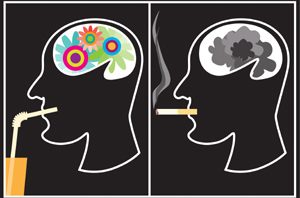As we are all aware, smoking has some pretty severe possible side effects that result in physical changes inside and outside your body that could potentially cause death. Something that we don’t make as public is the effects that smoking has on the brain and what about nicotine a person gets addicted to.
Nicotinic acetylcholine receptors (nAChRs) are ligand-gated ion channels that mediate fast signal transmission at synapses. In the brain nAChRs are found between neurons at the synapses they are involved in cognitive function, learning and memory, arousal, reward, motor control and analgesia. Activating nAChRs causes and influx of calcium ions, which affects the release of neurotransmitters.
Nicotine gets into the blood stream and can easily cross the blood-brain barrier. Initially, nicotine activates nAChRs, opening their channels causing the high and the feeling that users will get. The excessive stimulation causes a decrease in receptor synthesis. Nicotine ends up desensitizing the receptors.
Once the receptors are dysfunctional there is an sudden increase in the amount of certain nACHRs. With more receptors to please there is more of need for nicotine which drives the addiction. The amount of receptors you have eventually can go back to normal, but it is tough. The withdrawal symptoms a smoker goes through often times lead to relapse.
Messing with nAChR amounts and functions disrupts normal brain function. nAChRs play a huge role in learning and memory. There are studies that show smokers to have a lower IQ than non-smokers.
After advertising how unhealthy smoking is there has been a huge decrease in the amount of people who smoke. Web M.D. says that the transition from cigarette smoking to e-cigarettes happened pretty quickly. Unfortunately the research didn’t quite move as fast and the potential long-term effects have not been discovered.
The idea behind e-cigs is that they take away one of the most dangerous effects of cigarettes: the smoke from tobacco. Another term for using an e-cig is “vaping”. E-cigs still contain nicotine, so they have the same effects on the brain as cigarettes. You can become addicted to them and could experience withdrawal symptoms. It seems to be that e-cigs might just be the lesser of two evils. It will need to be something that we keep on our radar. There could be decreased health benefits if a smoker can turn into a “vaper”.































